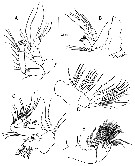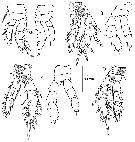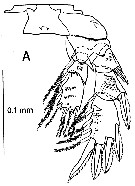|
|
 |
|
Calanoida ( Order ) |
|
|
|
Pseudocyclopoidea ( Superfamily ) |
|
|
|
Pseudocyclopidae ( Family ) |
|
|
|
Pseudocyclops ( Genus ) |
|
|
| |
Pseudocyclops juanibali Figueroa, 2011 (F,M) | |
| | | | | | | Ref.: | | | Figueroa, 2011 (p.727, Descr.F,M, figs.F,M, genetic analysis); Laakmann & al., 2019 (p.330, fig. 2, 3, phylogenetic relationships) |  issued from : D.F. Figueroa in J. Crustacean Biol., 2011, 31 (4). [p.728, Fig.2]. Female (from 00°45.426'S, 90°18.932'W): A-B, habitus (dorsal and lateral, respectively); C, urosome (ventral); D, A1. Male: E-F, habitus (dorsal and lateral, respectively); G, right A1. Nota Female: Prosome 6-segmented. Large eye in anterior forhead, red/orange pigmented. Rostrum simple strong process, produced ventrally. Urosome 4-segmented. Anal segment gtelescoped into preceding somite with thick row of very fine setae on dorsal surface. Genital double-somite symmetrical, with paired gonopores. Caudal rami symmetrical bearing 6 setae each. A1 symmetrical 18-segmented, barely reaching 1st pedigerous somite. Nota Male: Body as in female.
Urosome 5-segmented.
Left A1 as in female; right A1 18-segmented, geniculate between segments 14-15 (distal margin of segment 16 projecting as a spinular process.
Mouthparts and legs P1-P4 as in female.
|
 issued from : D.F. Figueroa in J. Crustacean Biol., 2011, 31 (4). [p.729, Fig.3]. Female: A, A2; B, Md; C, Mx1; D, Mx2; E, Mxp. A2 with coxa and basis partly fused. Endopod 3-segmented; exopod indistinctly 6-segmented, first 3 segments partly fused. Md: Gnathobase bearing several short, stout teeth and with a thickened subapical subapical ridge giving the appearance of an articulation. Endopod 2-segmented; exopod 4-segmented. Mx1: Praecoxal endite with 7 ventral setae, 1 anterior seta and 4 posterior setae; coxal exite with 4 setae; coxal endite with 3 setae; basal exite with 1 seta, proximal and distal endites with 3 setae each; exopod with 3 + 7 setae; endopod unsegmented with 4 + 4 mid-ventral setae and 6 terminal setae. Mx2: Praecoxal endite bearing 5 setae, coxal endite with 3 setae; proximal and distal basal endites with 3 setae each; endopod 3-segmented, 1st segment with 6 setae on ventral lobe, 2nd segment with 2 inner and 1 outer setae; distal segment with 5 setae. Mxp: 3 syncoxal endites bearing 1, 2 and 3 setae, respectively; coxal endite bearing 3 setae; basis with proximal endite bearing 3 setae, distal endite bearing 2 setae; endopodite indistinctly 5-segmented with seta formula: 2, 2, 2, 3 +1, 4.
|
 issued from : D.F. Figueroa in J. Crustacean Biol., 2011, 31 (4). [p.730, Fig.4]. Female: A-D, P1 to P4 respectively. All posterior view, with anterior surface spinulation shown to the right for P1-P3.
|
 issued from : D.F. Figueroa in J. Crustacean Biol., 2011, 31 (4). [p.732, Table 1]. Female: Setae and spine formulae for legs P1-P5. Arabian numerals: setae; Roman numerals: spines).
|
 issued from : D.F. Figueroa in J. Crustacean Biol., 2011, 31 (4). [p.731, Fig.5, A]. Female: P5 (posterior view).
|
 issued from : D.F. Figueroa in J. Crustacean Biol., 2011, 31 (4). [p.731, Fig.5, B-D]. Male: B, P5 (posterior view); C, coxa, basis and endopod of P5 (posterior view); D, exopod of left P5 (posterior view); E, right exopod of P5 (posterior view). Nota P5: Left coxa fused with basis; right coxa separate from basis. Right leg with 2-segmented exopod, 1st segment with lateral spine on outer margin and thick, elongate medial seta; 2nd segment elongate, with thick base and curved, spine-like distally serrated attenuation with 2 thick setae on proximal inner margin; right endopod in form of elongate, lamellar, distally forked lobe with row of denticles along distal outer margin. Left basis with long, slender process originating on anterior surface near inner margin; left exopod 2-segmented, 1st segment bearing outer spine, with serrated margin, 2nd segment bearing 3 membranous processes, first 2 broad and leaf-like, with marginal folds, 3rd elongate and slender. left endopod an unsegmented lobe, with 4 tooth-like attenuations on distal end bearing 4 setae and with pronounced cleft on distal inner margin.
| | | | | NZ: | 1 | | |
|
Distribution map of Pseudocyclops juanibali by geographical zones
|
| | | | Loc: | | | E Pacif. (Galapagos: Santa Cruz Is.) | | | | N: | 1 | | | | Lg.: | | | (1104) F: 0,69-0,74; M: 0,64-0,68; {F: 0,69-0,74; M: 0,64-0,68} | | | | Rem.: | Anchialine pool.
For Figueroa (2011, p.732) this species is most similar to P. australis Nicholls, 1944. There are key characters that are shared by P. australis Tanaka's specimens and P. juanibali, but also with differences. | | | Last update : 02/04/2019 | |
|
|
 Any use of this site for a publication will be mentioned with the following reference : Any use of this site for a publication will be mentioned with the following reference :
Razouls C., Desreumaux N., Kouwenberg J. and de Bovée F., 2005-2025. - Biodiversity of Marine Planktonic Copepods (morphology, geographical distribution and biological data). Sorbonne University, CNRS. Available at http://copepodes.obs-banyuls.fr/en [Accessed December 26, 2025] © copyright 2005-2025 Sorbonne University, CNRS
|
|
 |
 |








